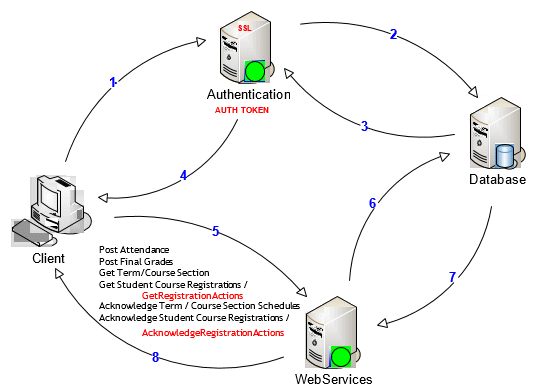Web Service Interaction Method
Each Web service has a request and response defined so there is always a 1 to 1 ratio of “in” messages to “out” messages. WSDL files are is installed by the Web service package so that your applications and tools can ‘discover’ the exact way to communicate with the Web service.
The application programmer has one choice when interacting with the Web service: single transaction. The single transaction approach supports multiple in-messages in a request. Each message is handled like a single Web request.
Each in-message has a corresponding out-message in the Web service response allowing your application to determine what application records succeeded or failed and what the failure was.
Messaging Overview

The process for sending and receiving data through Web services is as follows:
-
A client application prepares an authentication message containing an existing Anthology Student username and password. The client application calls a method in the Authentication Web service to request a token for the session.
Note: It is recommended that the Security Web site be configured with SSL.
-
The Authentication Web service authenticates the user against the Anthology Student database.
-
The Authentication Web service prepares an authentication token. The token has an embedded time-to-live (TTL) value. This value is configurable.
-
The client application receives a response message and extracts the authentication token which must be used in subsequent API calls before it expires.
-
The client application can then call the Web service to do the relevant tasks. The Web method requires a request message to be prepared with specific information (see API Message Fields).
In addition, the request must contain the authentication token obtained earlier. The client application can use the same token to make multiple Web service requests as long as the token has not expired.
The Web services Web site can optionally be configured with SSL.
-
The Web service processes the request message. Each Web service API has a distinct set of message interface parameters. The API extracts these parameters and uses them as criteria to post/get data from the Anthology Student database.
-
The results are returned to the Web service and placed in a response message.
-
The client will receive a response message.
-
If a Post request was sent by the client, the response message will contain status information.
-
If a Get request was sent by the client, then, in addition to status information, the data requested will also be included in the message.
-
If a Get request was sent by the client, the client is also responsible for sending an acknowledgment message so that the data selected is not selected again on the next call.
-